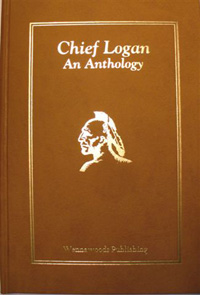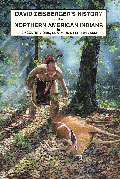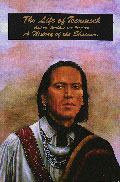For the scholar, student, and
interested reader...
Subjects
Native American
History & Culture
The Early Frontier
Colonial & Indian Wars
The Missions
Indian Languages
Explorers &
Pioneers
American Dialects
|
Native American History &
Culture
Chief Logan
An Anthology
By Franklin B. Sawvel, Brantz Mayer, and Ronald R. Wenning
This
anthology is made up of the following works: Logan the Mingo by Franklin B.
Sawvel, Tah-Gah-Jute, or Logan and
Captain Michael Cresap by Brantz Mayer, and Chief Logan: Friend, Foe or Fiction?
by Ronald R. Wenning.
Sawvel's work was originally published in 1921
and represents the first
attempt at a full and complete biography of Chief Logan. The
selection from Mayer was originally published in 1851 as the
proceedings of a lecture delivered before the Maryland Historical
Society, and includes a selection of letters by Gen. George Rogers
Clark and others concerning Logan. This selection also includes six
versions of the famous speech given by Chief Logan which are among the
most famous words ever spoken by an American Indian. The final
selection is an essay by Ronald Wenning which draws together several
bits of information about Logan from a variety of sources.
2006 ~ 220pp ~ hardcover ~ 1-889037-42-7 ~ $34.95
|

|
Women in New France
Extracts from the Jesuit Relations
Compiled and Edited by Katherine E. Lawn & Claudio R. Salvucci
Volume 5
presents extracts from the Jesuit Relations that record
first-hand observations made by the Jesuit fathers in New France
regarding the roles, traditions, words, and actions of both Native
American and colonial European women from 1634 to 1790. Together, these
extracts present a vivid, poignant, and emotional portrait of the lives
and deaths of women in early colonial North America.
To best illustrate the differing roles and changing
circumstances affecting women in this historical setting, the extracts
are organized chronologically according to tribal, ethnic, and
settlement groupings. Covered in detail are the Montagnais, the various
Algonquin nations, the
Hurons, Iroquois and Iroquoian-speaking nations (Petun, Neutrals,
Eries, and
Wenro). Extracts covering the tribes of the lower Mississippi (Houmas,
Chickasaw,
Natchez, etc.) and the plains (Sioux and Akensas) are also included.
Finally,
several chapters include extracts dealing with the lives of colonial
French
women, Catholic nuns, and both native and European women’s lives in the
mission
towns.
An introduction written by the editors helps place
the extracts in their historical and cultural context and a
bibliography of related reading is included. A map of tribal
territories and movements from 1600–1700 is provided, as well as useful
appendices, including: A
synonymy of obscure tribal names contained in the extracts and an index
of principle persons mentioned in the extracts.
2005 ~ 324pp ~ hardcover ~ 1-889758-39-6 ~ $75.00
|

This title qualifies for
a 10% discount when
ordered online
|
The Country of the Neutrals
From Champlain to Talbot
by James
H. Coyne (1895)
This
history, written in 1895, gives a brief account of the country of the
Neutral tribe, who occupied numerous villages between the Grand and
Niagara Rivers in southern Ontario. Contact population for the entire
Neutral nation
was estimated to be 30-40,000, making them perhaps more numerous than
all
of the five nations of the Iroquois nations combined. They were termed
"Neutrals" because they historically did not take sides in the ongoing
wars
between their neighbors the Iroquois and the Hurons. The Neutrals
themselves
were attacked and scattered by the Iroquois in the early 1650s, leaving
hardly a trace of their language, history, and culture save what was
recorded
by the few missionaries that visited them beforehand. After their
reduction by the Iroquois, the remnants of the Neutral tribes seem to
have been
absorbed by the Iroquois or coalesced with refugees of the Petún
and Hurons to form the Wyandot tribe.
This book consolidates accounts of the Neutrals
recorded by early explorers and missionaries such as Champlain, De
Laroche-Daillon, Sagard, Brebéuf, Chaumonot, and others.
Together, these accounts provide an absorbing if fragmentary view of
this once great tribe. This book also covers the subsequent inhabitants
of the Neutral country: the Iroquois, French, Delawares, Mohawks, and
English up through the beginning of the 19th century. The book contains a short preface
detailing the original source of the work, is produced in a handy
small-format (4.25" x 6.75"), and features a durable library binding
and acid-free paper.
2004 ~ 80pp ~ BAENA3 ~ hardcover ~
1-889758-60-4 ~ $30.00
|

This title qualifies for
a 10% discount when
ordered online
|
David
Zeisberger's History of the Northern
American Indians
in 18th Century Ohio,
New York, & Pennsylvania
Edited by
Archer B. Hulbert & William Nathaniel Schwarze (1910)
David
Zeisberger was a Moravian missionary who worked among the Indians of
present-day New York, Pennsylvania, and Ohio. His career lasted more
than 60 years and during that time, he became intimately
familiar with the tribes of the region. This book brings to light many
interesting stories of Indian history, manners, and customs
of everyday life. This exceptionally detailed account is found in
few other places in the early literature. Included are stories of
Indian medicinal remedies, firsthand details of their ceremonies, food,
culture and beliefs. Tribes discussed include the Delawares, Shawnee,
Iroquois, Cherokee, Nanticokes, and many others.
2000 ~ 190pp ~ paperback ~ 1-889037-17-6 ~ $19.95
|

|
The Life
of Tecumseh and His Brother the Prophet
A History of the Shawnee
by Benjamin Drake (1855)
American
historian Henry Trumbull stamped Tecumseh as “the most extraordinary
Indian that has appeared in history,” and today, almost two centuries
after his death, Tecumseh still looms as the greatest native leader in
the long and tragic struggle of the American Indians to hold
on to their homeland.
Written in 1841 and published in 1855, this
book describes the story of that great leader and his people and their
struggle with life and their pursuit
of an Indian homelands fairly and accurately. Using many original
sources, including General Harrison’s personal papers, Drake brings
Tecumseh and the Shawnee vividly to life once more.
1999 ~ 236pp ~ paperback ~ 1-889037-21-4 ~ $19.95
|

|
A History
of the Indian Villages and Place Names
in Pennsylvania
by George P. Donehoo (1928)
Perhaps no state
is richer in Indian names or history than Pennsylvania. Indeed, Indian
place names are positively everywhere--Manayunk, Conshohocken,
Kittatinny, Wisahickon, Lackawana, Perkiomen, Monongahela, Allegheny,
etc. This book links PA Indian place names to their correct form,
origin, and history. Each Indian name comes complete with historical
notes by the author. A list of the authorities used is given with
each name and a general bibliography follows at the conclusion of
the work.
1998 ~ 290pp ~ paperback ~ 1-889037-117 ~ $19.95
|

|
|

